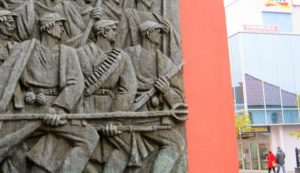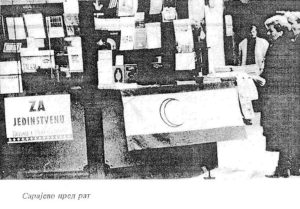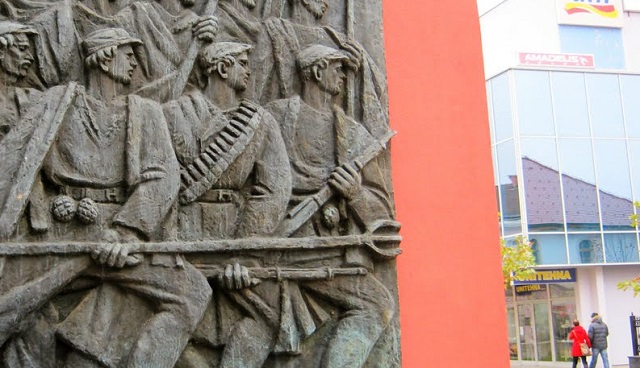On the day of 30th of April 1992, some 400 Serbian police officers took control in the city of Prijedor while the remaining territory of the Prijedor Municipality was divided between Serbian and Muslim-Croatian military formations.

It was a genuine uprising of the Serbs in Prijedor who refused to share the fate that befell the Serbs in Posavina, central and eastern parts of the Bosnia and Herzegovina, who became victims of the Muslim and Croatian paramilitary units and regular units from Croatia as well, such as those which attacked Bosanski Brod on 3rd March 19922, or Kupres on 3rd April of the same year3.
Muslims and Croats in Prijedor had their own paramilitary organizations as early as 1991. Testimony to the level of preparedness and strength of the Muslim paramilitary is the fact that the Regional HQ of the Patriotic League Banja Luka was located in Prijedor4 and from 9 regional headquarters, it was the only one located outside the administrative center of the region it was designated for. Other regional HQs were all placed in the centers of their region, those centers being: Bihać, Livno, Doboj, Tuzla, Zenica, Sarajevo, Goražde and Mostar5.
Arming of the Muslim-Croatian extremists began much earlier than the first war clashes in Bosnia and Herzegovina. It was done in secrecy through activities of the so-called Crisis HQ formed in October 1991 whose members were exclusively Muslims. Director of the so-called Crisis Headquarters was Muhamed Čehajić, at that time President of the Municipal Assembly of Prijedor and member of the Executive Board of SDA for Prijedor. Members of the Crisis HQ were all members of the SDA party. Mirsad Mujađić was president of the Executive Board of SDA for Prijedor, Bećir Medunjanin was the secretary of the Secretariat for peoples defense for Prijedor, Hilmija Hopovac from Ljubija, Mustafa Hodžić from Kozarac and Đamil Pezo from Prijedor. From these facts we can see that despite having authority in Prijedor, SDA party was still gearing itself towards confrontation with Serbian population, which, without doubt, confirms its narrative about civil and multiethnic Bosnia and Herzegovina was nothing more than a charade masking the true goal, creation of the unitary Bosnia and Herzegovina. This image, from Sarajevo, just prior the outbreak of the civil war is worth more than a thousand words:

During March and April 1992, conflict raged throughout Bosnia and Herzegovina. First victims of this conflict were Serbs who were killed, tortured and imprisoned in Sarajevo, Bosanski Brod, Derventa, Kupres, Mostar and in many other locations. Serbs were, likewise, taken into camps located in Croatia like the one in Metković, Split, Šibenik and Zadar7.
Muslim-Croatian part of the Presidency of the Bosnia and Herzegovina already, on 4th April 1992, proclaimed general mobilization8. During that time, situation in Prijedor was tense but was devoid of open combat operations. Situation took a sharp turn on the 29th of April when the chief of the reformed Territorial Defense HQ, which was previously cleared of all Serbian cadres, Hasan Efendić gave order to all municipal and regional Territorial Defense HQs of Bosnia and Herzegovina on execution of the decision made by the so-called Presidency of B&H to attack all remaining units of Yugoslav People’s Army which have not yet withdrawn9.
HQ of the B&H Territorial Defense, instead of relaying order for engagement and expulsion of regular units of the Croatian army which were coming from Croatia proper and in concert with Croatian and Muslim paramilitary units were committing crimes against Serbian civil population, decided to liquidate remnants of YPA which had many members originating from Bosnia and Herzegovina and in whom Serbian people saw protectors from regular Croat units and paramilitary units of Croats and Muslims from Bosnia and Herzegovina.
Despite earlier agreement which assured YPA would be allowed to stay five further years, until 1997, and equally protect all citizens until political solution was found, rump Presidency of the SFRY decided that that all remaining units of YPA must withdraw from Bosnia and Herzegovina before 19th of May 1992. It would seem that Territorial Defense HQ of B&H was unwilling to wait and were eager to spill the blood of young recruits, in manner done in Tuzla and Sarajevo.
Serbs in Prijedor knew of the Hasan Efendić order, and given the fact that Serbs suffered in every place YPA withdrew from and overall conflict in the country, in early morning hours of 30th April Serbian police officers assume control of the Prijedor without a single dead person11. As soon as Serbs took control of Prijedor, offer for recognition of the new authority was made to the entire non-Serb population so larger conflicts and casualties could be avoided. However, given that Muslims and Croats were already prepared for war, their paramilitary formations refused peaceful settlement of the situation and responded to the offer by attack and capture of police outpost in settlement of Ljubija. Group which executed the attack was led by Muharem Ramić, member of the Prijedor Center of Public Safety who, in an earlier instance, underwent training with Ministry of Internal Affairs of Republic of Croatia. Following him, in the attack participated Esad Kadić, Rasim Dedić, Ismet and Luka Buzuk and Amir Selman12.
The first victim fallen in combat against extremists, Radenko Đapa13, member of the Center of Public Safety Prijedor, died a day later, on 1st of May. Even after everything that happened, Serbs were still interested in negotiations and initiated them with Muslim-Croatian representatives, who formed their own war HQ on May the 3rd in Hambarine14 . Negotiations failed which later on lead to open clashes with casualties on both sides at the end of May, which is to a great extent fault of the political and military leadership of Muslims and Croats in Prijedor.
Commander of the Patriotic League, Meho Kariška, known as “Kemo” testified on planning and the strength of Muslim paramilitary forces prior to conflict in Prijedor: “We had a lot of weapons in that part of our country. We knew this, and the same thing now is claimed by Mirza Mujađić, at that time, the most responsible person for that area. So, Patriotic League could have given stiffer resistance, but it would seem that someone from Sarajevo estimated our chances of success were non-existent. This directly influenced the events in the valley of Sana, and what happened, happened”15 .
The same Mirza Mujađić mentioned above used to work on Radio Prijedor and, after Serbs seized control, had a direct confrontation with Simo Mišković, president of SDP(SDS) for Prijedor, where he condemned Serbian takeover all the while being one of the most important SDA operatives with task of supplying weapons to Muslim and Croat paramilitary units in Prijedor and at the same time working on complete takeover of Prijedor by forces of SDA16. This can serve as an excellent example of perfidy and hypocrisy of the SDA members, only confirmed on numerous examples during and prior to the civil war in Bosnia and Herzegovina.
Once again, Serbs of the Prijedor region have shown courage and determination which were qualities adorning their ancestors during WW II, when Serb peasantry were at the forefront of the antifascist struggle while at the same time fighting for bare survival against Croatian and Muslim Ustasha formations their genocidal idea. Unlike the WW II, this time, luckily, numerous Serbian victims in Prijedor and surrounding areas were prevented, and that is the most important success of the Serbian Prijedor uprising. Generations to come should commemorate 30th April as a day when history of persecution against Serbs of Prijedor was prevented from repeating itself and when the hand of peaceful cooperation was offered to others. City authorities could express their respect to the importance of this day by naming one of the streets of the city “30th of April” and with suitable manifestations could show gratitude to those people who would not allow discrimination and violation against Serbian people of Prijedor. In the end, to all citizens of Prijedor and Republic of Srpska who remember and commemorate this day, we wish happy 30th of April, the day of Prijedor uprising.
Author: Boris Radaković
Translate:Ljubiša Malenica
Донирајте или се рекламирајте на „Срби у Босни и Херцеговини кроз епохе и судбине“ једином сајту на свијету који описује живот нашег народа на просторима БиХ од насељавања Срба у 7. вијеку до одбрамбено-отаџбинског рата а кроз призме политичке, културне и духовне историје.

